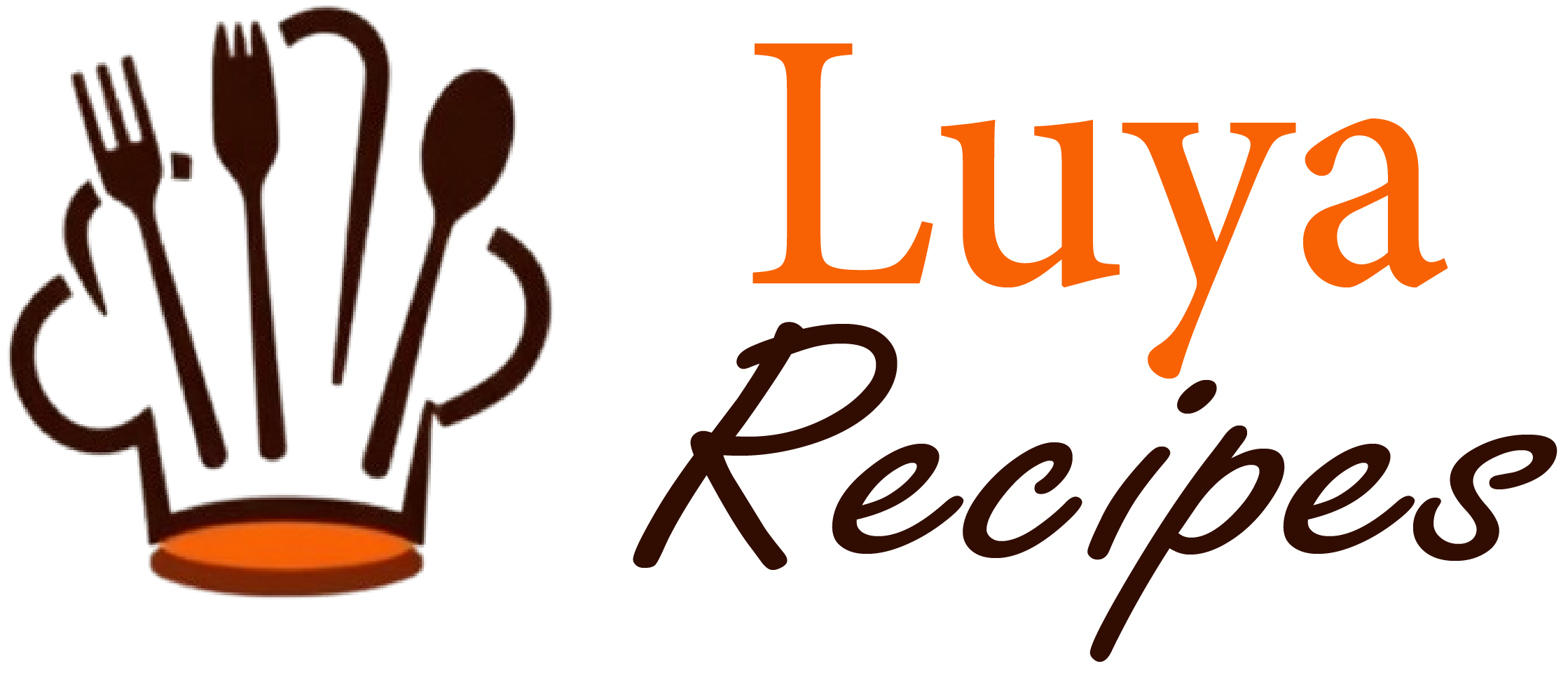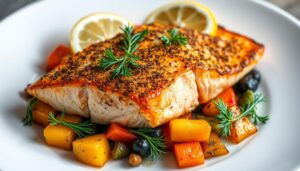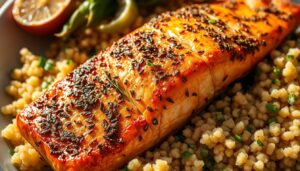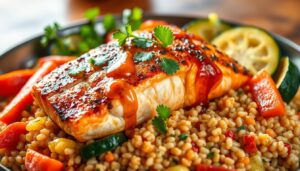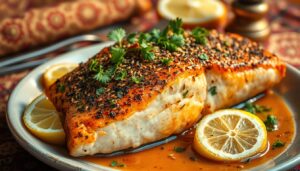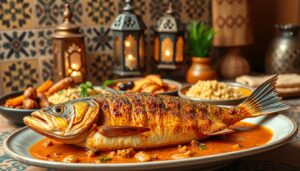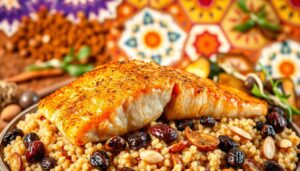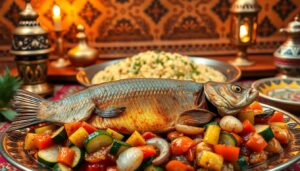The crisp autumn air carried the scent of pine and anticipation as I unwrapped the deer steak. Growing up in a hunting family, I learned that making wild game into a tasty meal is an art. It’s passed down through generations.
Your venison steak recipe journey starts with understanding its unique qualities. Unlike regular beef, deer meat needs special techniques. These unlock its rich, wild taste and keep it tender.
This guide will show you how to make the perfect deer steak recipe. You’ll learn about selecting the best cuts and mastering cooking temperatures. You’ll see how to turn your venison steak recipe into a culinary masterpiece.
Table of Contents
Understanding Venison Steak Basics
Wild game cooking introduces us to venison, a lean and tasty meat. It’s different from regular beef. Deer meat offers a unique taste that requires special cooking skills.
What Makes Venison Different from Beef
Venison has several key differences:
- It’s much leaner with less fat
- It has a rich, complex flavor from the deer’s diet
- It’s more nutritious than domestic beef
- It’s harder to cook because of its low fat
Common Cuts of Deer Steak
It’s important for wild game cooking fans to know the best cuts:
- Tenderloin: The most tender cut, perfect for quick cooking
- Backstrap: Known for its lean, tender meat
- Sirloin: A versatile cut for many cooking methods
- Shoulder: Great for slow-cooking
Nutritional Benefits of Venison
Venison is a great choice for those who care about their health. A serving offers:
- 62g of protein
- Only 15g of total fat
- It’s rich in iron and B vitamins
- It has low cholesterol
Choosing venison for wild game cooking means getting a protein that’s good for you and fun to cook with.
Essential Equipment and Tools
Cooking deer steak well needs more than skill—it requires the right tools. Both professional chefs and home cooks agree. Quality equipment can turn a simple venison dish into a memorable meal.
- Meat Thermometer: Essential for precise doneness
- Cast Iron Skillet: Great for a perfect sear
- Sous Vide Machine: Offers consistent temperature control
- Sharp Chef’s Knife: For precise cutting and trimming
- Tongs: Helps handle meat without piercing
Your meat thermometer is very important when cooking venison. Deer meat is leaner than beef, so tracking the internal temperature is key. Aim for 135°F for medium-rare or 140°F for medium. This ensures a tender and juicy steak.
A cast iron skillet is unmatched for heat distribution and creating a great crust. Seasoned cast iron adds depth to your deer steak’s flavor. It’s a must-have for cooking deer steak to perfection.
Pro tip: Invest in quality tools to transform your venison cooking from good to exceptional.
Think about using a sous vide machine for precise temperature control. This method guarantees consistent results, which is crucial for lean meats like venison. They can quickly become tough.
Perfect Marinade for Deer Steak
Creating a great recipe for deer steak begins with a top-notch marinade. Marinades make venison go from good to amazing, adding deep flavors and tenderizing the meat. Knowing how to marinate can boost your cooking skills and make your meal unforgettable.
Key Marinade Ingredients
A perfect marinade for deer steak needs the right ingredients. The best marinades mix:
- Acidic parts like apple cider vinegar or citrus juice
- High-quality olive oil
- Fresh herbs like rosemary and thyme
- Garlic and onion for extra flavor
- Worcestershire sauce for a rich taste
Marinating Time Guidelines
When marinating venison, timing is key. Recommended marinating times are 3 to 8 hours. Marinating overnight can soak the meat in flavor without making it tough. But, don’t marinate for more than 24 hours to avoid damaging the meat’s texture.
Storage and Safety Tips
Following proper marinating practices keeps your food safe and tasty. Always:
- Marinate in a non-reactive glass or ceramic container
- Keep it refrigerated during marinating
- Throw away used marinade after taking out the meat
- Don’t reuse marinade that’s been in contact with raw meat
“A great marinade transforms good meat into an extraordinary dining experience.” – Culinary Expert
Recipe for Deer Steak
Making the perfect venison steak recipe needs focus and knowing deer meat’s special traits. This recipe will turn your wild game into a dish that will wow everyone.
Here’s a detailed guide to making an outstanding deer steak:
- Prep Time: 5 minutes
- Cooking Time: 15 minutes
- Total Time: 20 minutes
- Servings: 2 people
- Venison Required: 1 pound of steaks
What you’ll need for your venison steak recipe:
- 1 pound venison steaks (1-inch thick)
- 2 tablespoons olive oil
- 4 garlic cloves, minced
- 1 teaspoon dried rosemary
- Salt and pepper to taste
Steps to prepare this tasty venison recipe:
- Take venison steaks out of the fridge 30 minutes before cooking
- Pat steaks dry with paper towels
- Season well with salt and pepper
- Heat olive oil in a cast-iron skillet
- Cook steaks 2-3 minutes per side for medium-rare
- Let rest for 5 minutes before serving
“The key to a perfect venison steak is minimal handling and precise cooking temperature.”
Nutritional highlights per serving:
- Calories: 226 kcal
- Protein: 35g
- Fat: 8g
- Cholesterol: 129mg
Pro tip: Always use a meat thermometer to ensure your venison reaches 130-135°F for medium-rare perfection.
Preparation Techniques
Preparing a perfect deer steak needs careful attention. Wild game cooking requires special techniques to make lean venison tasty. The right preparation can turn tough, gamey meat into tender, flavorful food.
Tenderizing Methods
Tenderizing venison is key for a delicious dish. You can use several methods:
- Marinating with acidic ingredients
- Mechanical tenderizing with a meat mallet
- Enzymatic tenderizing with natural ingredients like pineapple
Room Temperature Considerations
Bringing your deer steak to room temperature is vital. Let the meat sit out for at least 1 hour before cooking. This ensures even cooking and prevents toughness.
| Preparation Step | Recommended Time |
|---|---|
| Room Temperature Rest | 60 minutes |
| Ideal Steak Temperature | Around 55-60°F |
Seasoning Guidelines
Seasoning is crucial for your venison steak. Start with quality sea salt and black pepper. Season generously but carefully to enhance the meat’s natural flavors.
- Use coarse sea salt for better coverage
- Crack black pepper just before seasoning
- Consider herbs that complement wild game
Wild game cooking needs a delicate touch. Each step in preparation affects the final flavor and tenderness of your deer steak.
Cooking Methods and Temperature Guide

Learning how to cook deer steak well means knowing your cooking methods and keeping an eye on the temperature. Venison is lean and needs careful cooking to keep its flavor and tenderness.
Choosing the right cooking method can make your deer steak go from tough to tender. Here are the top ways to cook a great venison steak:
- Grilling: High heat for perfect sear marks
- Pan-searing: Creates a crispy exterior
- Sous vide: Precise temperature control
The ideal internal temperature for a perfect deer steak is key. Aim for medium-rare at 120-125°F to keep it moist and tender.
| Cooking Method | Temperature | Cooking Time |
|---|---|---|
| Grilling | 400-450°F | 3-4 minutes per side |
| Pan-searing | High heat | 2-3 minutes per side |
| Sous vide | 125°F | 1-2 hours |
Professional chefs say to let your deer steak rest for 5-10 minutes after cooking. This step lets juices spread out, making it moist and flavorful.
Pro tip: Always use a meat thermometer to guarantee the perfect doneness for your deer steak.
Seasoning and Flavor Enhancers
Turning a good deer steak into a memorable dish starts with seasoning. Your venison recipe needs the right spices and herbs to bring out its rich flavor.
Umami is key to boosting your venison’s flavor. Natural umami sources can add depth and complexity to the meat.
Best Spice Combinations
When making your venison recipe, try these spice blends:
- Classic Wild Game Mix: Garlic powder, black pepper, and dried thyme
- Herbal Mountain Blend: Rosemary, juniper berries, and sage
- Smoky Southwest Combination: Smoked paprika, cumin, and ground chipotle
Complementary Herbs
Fresh herbs can make your venison unforgettable. Choose herbs that match the meat’s strong flavor:
- Rosemary: Adds earthy, pine-like notes
- Thyme: Provides subtle, woodsy undertones
- Sage: Delivers a robust, aromatic flavor
Salt and Pepper Ratios
The right salt and pepper balance is crucial. For every pound of venison, use about 1 teaspoon of kosher salt and 1/2 teaspoon of freshly ground black pepper.
Pro tip: Always season your venison just before cooking to prevent moisture loss and maintain optimal texture.
Resting and Serving Tips
Mastering the recipe for deer steak isn’t complete without understanding the critical steps of resting and serving. After cooking your venison, patience becomes your secret weapon for an exceptional dining experience.
The resting period is crucial for your deer steak. During these moments, the meat’s internal juices redistribute, ensuring each bite remains tender and flavorful. Experts recommend allowing your steak to rest for 7 minutes after cooking, which helps maintain optimal moisture and texture.
- Let the steak rest on a warm plate
- Cover loosely with aluminum foil
- Avoid cutting immediately after cooking
When serving your deer steak, consider these professional presentation techniques:
- Slice against the meat grain
- Use a sharp knife for clean cuts
- Present on a pre-warmed plate
Pairing your venison with the right accompaniments can elevate your recipe for deer steak from good to extraordinary. Consider robust red wines or roasted seasonal vegetables that complement the rich, lean meat.
| Serving Recommendation | Suggested Pairing |
|---|---|
| Wine | Cabernet Sauvignon or Syrah |
| Side Dish | Roasted root vegetables |
| Sauce | Balsamic reduction |
Pro tip: Serve your deer steak immediately after resting to enjoy peak flavor and temperature.
Side Dish Pairings
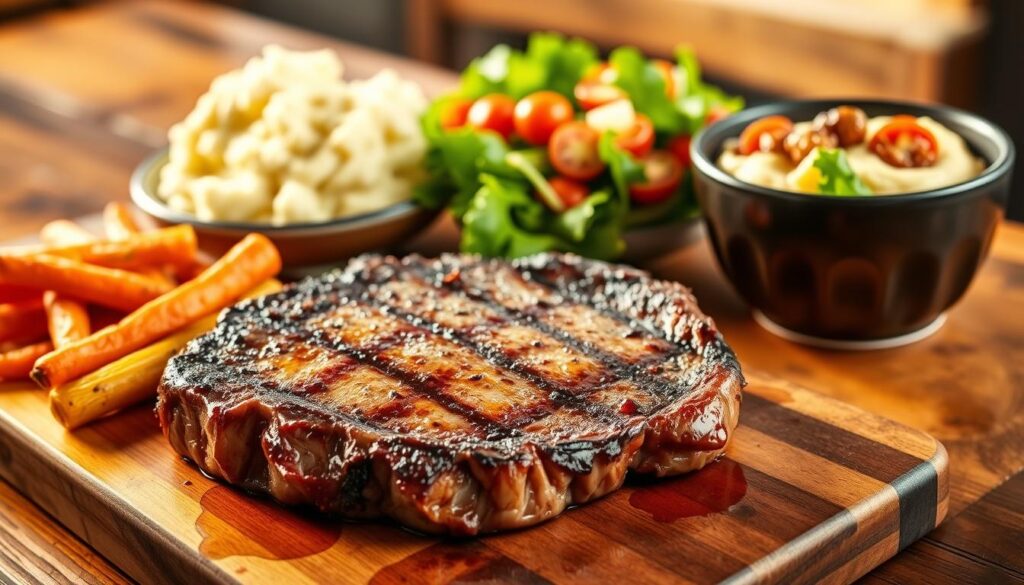
Choosing the right side dishes can make your venison steak recipe special. It’s important to pick sides that match the deer meat’s rich, earthy taste. This way, you avoid overpowering its delicate flavor.
Here are some tasty side dish ideas for your venison steak:
- Roasted Root Vegetables: Delicata squash or roasted carrots add a nice earthy touch
- Duck fat smashed potatoes with fresh herbs
- Mediterranean cucumber and tomato salad
- Garlic olive oil mashed potatoes
- Pan-fried asparagus or roasted cauliflower
Mushrooms pair amazingly well with venison. They bring an earthy flavor that boosts the meat’s taste. A wild mushroom sauté can make your venison steak recipe feel like a fancy restaurant dish.
Wine lovers can enjoy their meal even more by pairing venison with the right wines. Cabernet Sauvignon, Pinot Noir, or Zinfandel work great. These wines complement the deer meat’s rich flavors perfectly.
Pro tip: Choose sides that provide color, texture, and nutritional balance to create a visually appealing and satisfying plate.
Common Cooking Mistakes to Avoid
Cooking deer steak needs precision and careful attention. Wild game cooking can be tough, even for experts. Knowing common mistakes helps you cook venison perfectly every time.
Temperature Control Challenges
Managing temperature is key when cooking deer steak. Mistakes can make your tender cut tough and dry. Here are some common errors:
- Overcooking the steak beyond recommended internal temperatures
- Not allowing meat to reach room temperature before cooking
- Failing to use a meat thermometer for precise doneness
| Doneness Level | Internal Temperature | Cooking Recommendation |
|---|---|---|
| Medium Rare | 125°F | Remove from heat at 120°F |
| Medium | 135°F | Remove from heat at 130°F |
Seasoning Mistakes
Seasoning right can make your wild game cooking better. Avoid these mistakes:
- Under-seasoning the meat
- Using inappropriate spice combinations
- Applying salt too early or too late in the cooking process
Timing Errors in Wild Game Cooking
Timing is crucial when cooking deer steak. Watch out for these mistakes:
- Rushing the marinating process
- Not allowing adequate resting time after cooking
- Cutting the steak immediately after cooking
Avoiding these common errors can make your deer steak exceptional. Remember, practice and attention to detail are key in mastering wild game cooking.
Storage and Leftovers
Keeping your deer steak fresh is key to enjoying it more. Knowing how to store it is part of the best way to cook deer steak. Leftover venison can add flavor to many dishes if stored right.
- Refrigerate leftover deer steak within two hours of cooking
- Store in an airtight container or wrapped tightly in aluminum foil
- Keep refrigerated for up to 3-4 days
Here are some creative ways to use leftover deer steak:
- Slice thinly for gourmet sandwiches
- Chop and add to fresh green salads
- Use in quick stir-fries
- Create hearty deer steak hash
Freezing is great for long-term storage. Wrap the steak tightly in freezer paper or vacuum-seal bags to avoid freezer burn. Frozen deer steak stays good for up to three months.
| Storage Method | Duration | Best Practices |
|---|---|---|
| Refrigeration | 3-4 days | Use airtight container |
| Freezing | Up to 3 months | Vacuum-seal or wrap tightly |
Enjoying deer steak means proper preparation and storage. Follow these tips to keep your venison meal tasty and safe.
Conclusion
Making a delicious venison recipe is all about mastering key techniques. These steps turn lean venison into a memorable dish. With the right marinating, temperature control, and preparation, your deer steak will be amazing. Reviews show that with the right approach, anyone can make a great venison dish.
Starting your venison journey means learning several important steps. Marinating for 30 minutes to 4 hours makes the meat less gamey and up to 30% tenderer. Keeping an eye on the internal temperature, between 120°F and 140°F, ensures it’s juicy and full of flavor.
Patience is crucial when cooking venison. Letting the meat rest, using the right spices, and knowing cooking times greatly improve your dish. Try different marinades and cooking methods. Don’t be afraid to experiment. With practice, you’ll make venison dishes as good as professional chefs.
Your venison cooking journey is just starting. Be open to learning, stay curious, and enjoy the unique flavors. Each meal is a chance to get better and create unforgettable experiences.
FAQ
What is the best cut of deer steak for cooking?
The tenderloin and backstrap are the most tender and prized cuts. They are lean, flavorful, and great for quick cooking. The sirloin is also good, being versatile and a bit more affordable.
How long should I marinate deer steak?
Marinate for 4-8 hours for the best flavor. Don’t marinate more than 24 hours to avoid mushy meat. Always marinate in the fridge and use a non-reactive container.
What internal temperature is best for deer steak?
For medium-rare, aim for 130-135°F (54-57°C). Venison is lean, so don’t overcook it. Use a meat thermometer to check the temperature.
How do I prevent deer steak from being tough?
To avoid toughness, marinate, bring to room temperature, and don’t overcook. Let the steak rest for 5-10 minutes after cooking. Tenderizing methods like meat mallets or papaya can also help.
Can I freeze deer steak?
Yes, you can freeze deer steak. Wrap it tightly in freezer paper or vacuum-sealed bags. For best quality, use within 6-12 months. Thaw slowly in the fridge to maintain quality.
What are the best seasonings for deer steak?
Herbs like rosemary, thyme, and sage are great for venison. A simple seasoning of kosher salt and black pepper works well. For more flavor, try spice blends with garlic powder and smoked paprika.
How is venison different nutritionally from beef?
Venison is leaner than beef, with fewer calories and less fat. It’s high in protein and essential nutrients like iron and zinc. A 3-ounce serving of venison has about 134 calories, compared to 250 in beef.
What cooking methods work best for deer steak?
Pan-searing, grilling, and sous vide are the best methods. Pan-searing creates a crust, grilling adds smoky flavor, and sous vide ensures precise temperature. Cook quickly to avoid overcooking.
Source Links
- How to Cook a Juicy Venison Steak | Marinated Deer Steak – https://www.missallieskitchen.com/venison-steak/
- How to Cook Deer Steak with Creamy Mushroom Sauce – https://wildgameandfish.com/how-to-cook-deer-steak/
- Grilled Marinated Venison Steak Tasty And Tender – https://allourway.com/grilled-marinated-venison-steak/
- How to Cook Venison – https://www.outdoorlife.com/hunting/how-to-cook-venison/
- How to cook venison – https://www.bbcgoodfood.com/howto/guide/how-to-cook-venison
- Venison Steak Recipe – https://www.castironskilletcooking.com/cook-venison-steak/
- Venison Steaks – https://www.tasteofhome.com/recipes/venison-steaks/?srsltid=AfmBOopSLUopRVRUMaatffNf3DWi0Zwzr29OyBgFlg3hPIk5tgLU5yp3
- The Best Venison Tenderloin Recipe – https://www.castironskilletcooking.com/venison-tenderloin/
- Perfect Marinated Venison Steaks | How to Cook Deer Steak – https://www.therusticelk.com/marinated-venison-steak-recipe/
- All-Purpose Venison Marinade – Miss Allie’s Kitchen – https://www.missallieskitchen.com/all-purpose-venison-marinade/
- Pan fried Venison Steak Recipe – https://foodmeanderings.com/pan-fried-venison-steak-recipe/
- Slow Cooker Venison Steak – https://meateatingmilitaryman.com/slow-cooker-venison-steak/
- Juniper, Balsamic and Wine Venison Steaks Recipe – Bowhunter – https://www.bowhunter.com/editorial/juniper-balsamic-and-wine-venison-steaks-recipe/309181
- How to cook the perfect venison steak – https://www.schoffelcountry.com/en-us/blogs/the-ruralist/cooking-the-perfect-venison-steak
- How to Cook Deer Meat: Best Ways to Prepare Venison | Whitetail Properties – https://www.whitetailproperties.com/knowledge-center/how-to-cook-deer-meat-best-ways-to-prepare-venison
- The Perfect Temperature for Venison? Medium Rare – https://food52.com/blog/28701-how-to-cook-venison?srsltid=AfmBOoqPUvthzEEHta2AJUFOy-wVLtVj2vOuH4-xDnXKGvc2aUy_7gM9
- How to cook venison – https://www.bbcgoodfood.com/howto/guide/how-to-cook-venison/
- The 5 Things You Should Know About Cooking Venison – https://www.southernliving.com/food/meat/the-5-things-you-should-know-about-cooking-venison?srsltid=AfmBOopnDS7CVzXxDmyTiEjadWQaRG9xXj-G9Dy1_JRaA3oNGX0jIYl7
- Secrets to Mouthwatering BBQ: Discover the Power of Umami Spices – https://butcherbbq.com/blogs/news/unlock-the-secret-to-mouthwatering-bbq-discover-the-power-of-umami-spices?srsltid=AfmBOornUnqxKG95ObBowG-Zz4o0Bb9UOQ6omHicKzisAI1SZMsDQtPW
- Backwoods® Venison Bacon Seasoning | LEM Products – https://www.lemproducts.com/product/backwoods-venison-bacon-seasoning/bacon-ham-seasoning?srsltid=AfmBOoo-Kx8gXQsYfOkHXCUv-igGymM3Xz76cbIdn-s_pjX9P9YoyVSP
- Steak Marinade – https://www.tasteofhome.com/recipes/best-steak-marinade/?srsltid=AfmBOop1yP69FJ3URADvWvT1AstsJaIPwupHG4fjCLeojZHCIfxg4JVI
- 13 Steps for Broiling the Perfect Venison Backstrap | Grand View Outdoors – https://www.grandviewoutdoors.com/wild-eats/13-steps-for-broiling-the-perfect-venison-backstrap
- The Perfect Temperature for Venison? Medium Rare – https://food52.com/blog/28701-how-to-cook-venison?srsltid=AfmBOoqoOq-mdGR_PVN2VqoiW83FKLj0IS6TwLSlX2_5GeIrNoW9OMD8
- 20+ Venison Steak Recipes | Peak to Plate – https://peaktoplate.com/venison-steak-recipes/
- The Best Venison Steak with Oregano | Easy Recipe – The Home Intent – https://thehomeintent.com/venison-steak-with-oregano/
- Mastering the Art of Grilling the Perfect Steak with BBQ – – https://butcherbbq.com/blogs/news/mastering-the-art-of-grilling-the-perfect-steak-with-butcher-bbq?srsltid=AfmBOoqFVX8ujH1XGPSd8kOcPwIx7C5FQ13tB9-pYaQHyZLeaJql6myd
- 50 Kitchen Mistakes You’re Probably Making—And How to Fix Them – https://www.rd.com/list/stupid-kitchen-mistakes/
- Best Venison (Deer) Steak and Gravy Recipe – Jessie’s – https://jessiesfoodfaithandfamily.com/how-to-make-deer-steak-and-gravy/
- Best Hearty Braised Venison Stew – https://www.healthyseasonalrecipes.com/best-venison-stew/
- The BEST Grilled Venison Backstrap – JennDanella.com – https://jenndanella.com/grilled-venison-backstrap/
- Can you make venison taste like beef? – https://farmfieldtable.com/blogs/farm-field-table-a-butchers-perspective-blog/can-you-make-venison-taste-like-beef?srsltid=AfmBOoqTStTvA8Utyilxof_dnzyZeBdsFQiGquskxV31fluE0udSDCR1
- Unlock the Venison Flavor: Mastering the Art of Smoking Deer Meat – – https://butcherbbq.com/blogs/news/unlock-the-flavor-mastering-the-art-of-smoking-deer-meat?srsltid=AfmBOopt5f6_YM7dy5YqrO_HzvlWfcYXmBkqXQHcjhGnGqHASATXACJ8
